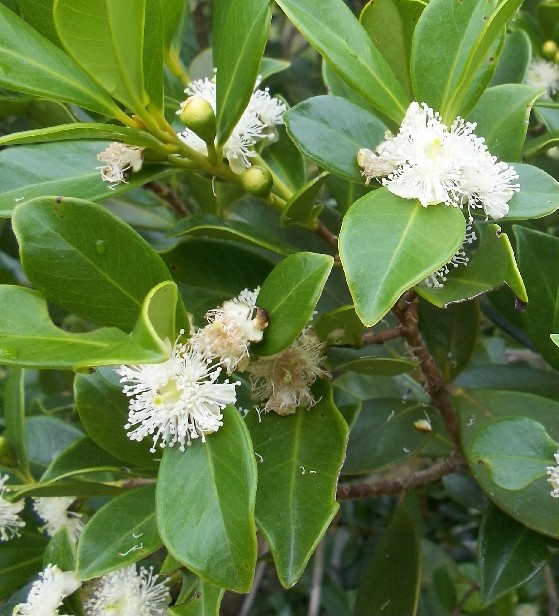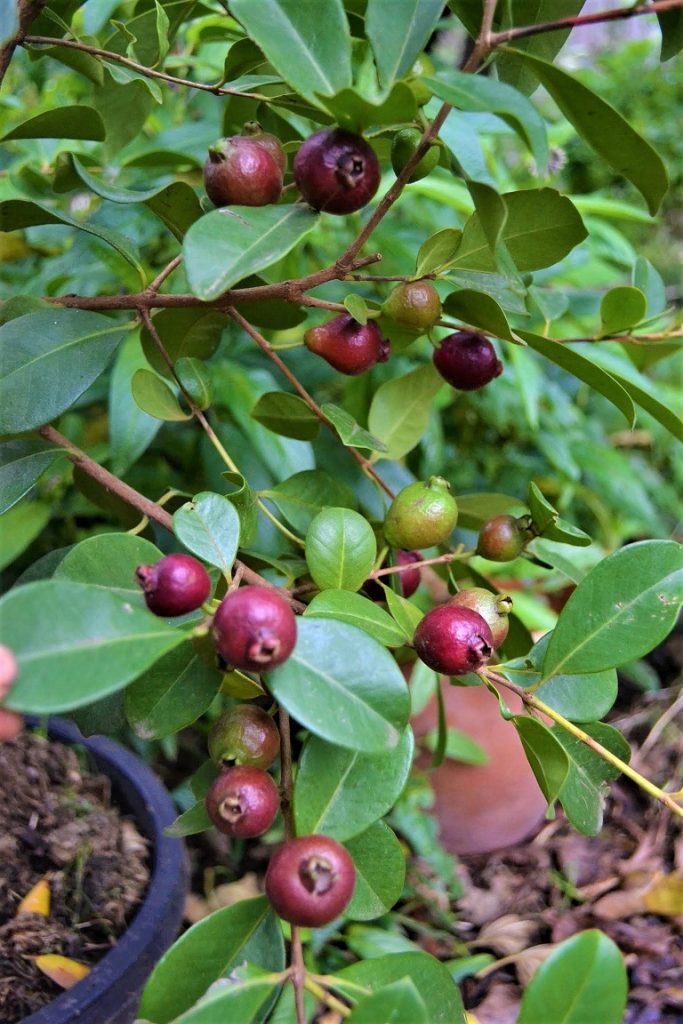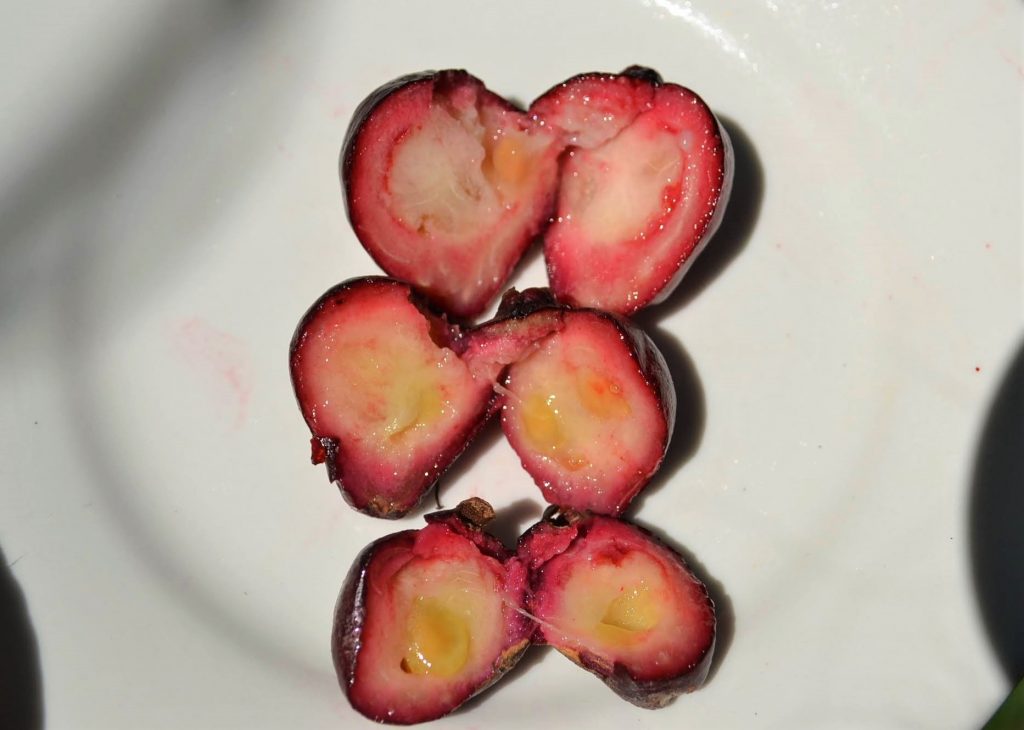Strawberry Guava is one of our favourite fruits to grow – it’s drought-tolerant, disease-resistant and delicious. One of the toughest fruits in our foodforest, yet produces delicious fruit with a delicate strawberry flavour. A wonderful addition to the tricky dry shade positions in the lower-canopy of a food forest. Did you know both the fruit and leaves are edible? Watch our video tutorial below or read on to learn how to grow Strawberry Guava and all about this fantastic fruit including a taste test.
Why should I grow Strawberry Guava?
Strawberry Guava (Psidium cattleyanum), also known as Cherry Guava and Cattley Guava, is an evergreen tree or shrub. It is native to Brazil and South America and is closely related to the common guava, Lemon guava (yellow cherry guava) and Feijoa (Pineapple Guava). This is absolutely one of the toughest fruits you can grow.

Here are all the many reasons we love to grow it:
- Strawberry guava is a prolific producer of plump deep purple berries, a bit larger than a cherry in size. They are sweet and juicy with a delicious strawberry aroma. A favourite in our household and with our kids who have been known to strip the whole bush bare in one sitting! They are highly nutritious, being an excellent source of Vitamins A and C, fibre, omega 3 and 6 fatty acids, trace minerals and antioxidants.
- It is a pretty evergreen tree with glossy leaves and attractive bark. It’s as ornamental as it is productive and looks good year-round. Strawberry guava can be grown as a dense hedge or in an attractive tree form. It produces fluffy yellow-white flowers in the warmer seasons.

- Not cold-sensitive like many of the other more ‘tropical’ guavas, Strawberry guavas are very hardy and can handle mild frosts and temperatures down to -5°C (22°F).
- It is drought-tolerant and even without any supplemental water in our blistering desert-like summers, it still looks good and produces an abundance of fruit.
- Being disease-free, there are no pests that bother it! The only thing in our garden that has nibbled on it before was a very hungry and desperate possum one year. But other than that nothing seems to touch it, which means more fruit for you!
- Not fussy about soil types, it will happily grow in soils high in salt, sandy, clay soil and high pH limestone soils. It can tolerate almost anything you can throw at it.
- Fruits almost continuously over the warmer seasons, giving you a steady harvest over late spring / early summer to early winter.
- Early producer of fruit and will fruit in its second to third year, so great for impatient gardeners!
- Finally, it grows happily in full sun and shade, yet still produces an abundance of fruit. Really useful for those dry shady positions in the lower canopy of a food forest. What’s not to love about this fruit!
Where should I plant Strawberry Guava?

In our video tour above, you can see that ours is growing in the toughest of tough conditions. It is planted below our huge and established grapefruit tree. Being an evergreen, our big grapefruit tree to the North-west shades out our Strawberry Guava for almost the entire year. This means our Guava gets very little direct sun.
It is also planted under the citrus tree’s canopy and does not get much rainwater, as well as having to compete with its roots. We have also underplanted our Guava with many plants, such as marjoram, pepino and parsley. Despite still being a baby tree (3 years old) with so much competition, it is flourishing and producing more berries and bigger fruit each year.
Without pruning, Strawberry Guava can grow up to a 5m tall tree, so it is not small by any means! For that reason, we have deliberately planted ours under our grapefruit tree and next to our Lemon Guava. By planting closely together, we can naturally dwarf our trees, making them more compact for backyard foodforests and allowing us to fit more varieties in.
The good news is that you can plant your Strawberry Guava virtually anywhere and it will likely flourish. It is particularly useful in designing a permaculture foodforest, as it can fill those tricky shady positions in the mid to lower canopy of your foodforest. It will however perform best grown with more sun, and a rich-free draining soil. But having said that it is not fussy at all and will still produce an incredible harvest in much poorer conditions!
What does Strawberry Guava taste like?

The fruit is juicy and sweet, with strawberry undertones but overall very tropical and fruity tasting. It has a delicate texture and a custardy inside similar to other Guavas. Some people find that Guava tastes musky, but we can’t taste any muskiness at all – in fact, it is said that Strawberry Guava is less musky than other Guavas. The fruit has tiny pips and is safe to eat for young children. You can simply crunch through the pips (surprisingly fun!) or spit them out.
Strawberry guava should ideally be eaten when deep purple, soft to the touch and when it has a strong strawberry aroma. At this stage it has developed all its sugars and a rich flavour. Picked earlier when pale pink, you will find that it is quite tart and doesn’t have the same complexity of flavour. The longer you leave Strawberry Guava on the tree, the deeper the colour and the sweeter the taste! Eventually they will drop off the bush, so remember to look on the ground for any delicious ripe fruit.
The fruit will ripen off the tree so you can pick early and store on the bench. It doesn’t last long so is best eaten quickly or stored in the fridge. It does freeze well and is wonderful popped cold into a smoothie or to make a berry ice-cream.
Check out our video above for a live taste test!
How do you use Strawberry Guava?

Strawberry Guava is a delicious snack eaten fresh, and the ideal size for a lunchbox. It can also be added to smoothies and drinks for a tropical twist. Once your tree is in full production, you will have enough to make into jam or jelly. It makes a rich and enjoyable jam very similar to Strawberry or Raspberry jam.
Not many people know this, but the leaves of all Guavas are edible and Strawberry Guava is no exception. The best way to use them is to steep a handful of leaves into a tea. You can also leave the leaves to dry and enjoy year-round. The leaves have lemon eucalyptus taste. Guava leaf tea is said to help with digestive issues, lowering cholesterol, weight loss and lowering blood pressure.
This is a fruit you can’t buy in the shops, it’s a valuable addition to your every Foodforest! This is one of the many unusual and productive fruits of our Foodforest. For a tour of the many other fruits of our Foodforest, check out our Video Tour and our Fruit growing guides.
Hi
We just bought a property and find a two small trees of strawberry guava on it, they not looking so good, have a few fruits and obviously looks like they were plant in not so good position( shade ).
So my question is can I replant them to some more suitable spot where they have fruits and feel happy for years to come. And of course will like to know how to do this safely and question is when is the best time of the year to do it, we are in New Zealand.
Will be grateful for reply and help.
Kind regards.
Catherine Shaw
What I fertilise my Cherry /Strawberry Guava with. Ours is about 5m tall